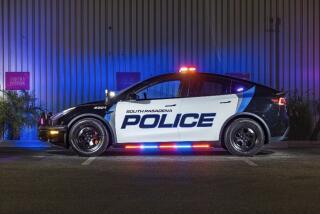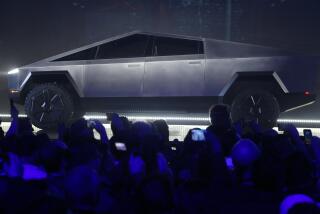Watching From the Wings : Despite Limitations, Downey Police High on Their Ultralight Eye in the Sky
- Share via
DOWNEY — Pilot Mike Carney was preparing for takeoff at “Downey International Airport,” the unofficial name of the nondescript hangar behind the tennis courts at Independence Park.
He picked up the ultralight aircraft by the tail and pushed it out onto the freshly cut grass.
The plane’s 40-horsepower engine started with one jerk of the flywheel. Children who were practicing their tennis strokes against a block wall turned to watch as the plane bounced along the grass before lifting off into a hazy sky.
Carney, a detective, took the Police Department’s new ultralight on a test flight Monday. The plane was donated to the city earlier this month by a Rancho California ultralight manufacturer that cited the public relations value of the pioneering Downey program, now in its fourth year.
The department today is the only one in the state that uses the ultralight for police work. The first department in the state and nation to use the ultralight, Monterey Park, had to abandon its program last December after a liability insurance policy was canceled. Other departments in California and around the nation have experimented with the ultralight and rejected it for a variety of reasons.
Critics of the ultralight say it is not suited for police work because the craft is slow, carries only one person and is stressful to fly. The plane also can be dangerous because it is vulnerable to strong winds and turbulence from other aircraft, critics say.
For small cities such as Downey, however, ultralights are a bargain, said police officials in Downey, Monterey Park and Tempe, Ariz., where the ultralight has been used successfully to apprehend burglars and car thieves.
For about the price of a new patrol car, the ultralight provides police on the ground with an inexpensive eye in the sky. While a new police helicopter can cost as much as $450,000, the ultralight, if Downey had paid for it, would have cost $13,000.
For that price, the department has an aircraft that, within minutes, can reach any spot in the 12.8-square-mile city. From a perch of 1,000 feet, the pilot has a panorama of every street and alley in the city. He can see a burglar hopping over a fence, distinguish makes and models of cars, and even determine the sex and clothing of people on the ground, Downey Capt. Jim Shade said.
“It (the ultralight) has proved itself beyond a doubt,” Shade said.
Since Downey police began flying an ultralight in February, 1983, the plane has been useful in more than 100 felony and misdemeanor arrests, police said. In 1985, the ultralight flew 300 hours and was used in 26 felony arrests for crimes such as burglary, armed robbery, grand theft, car theft, receiving stolen property and cultivation of marijuana, Sgt. Mike Miller said.
In three years of flying, the department has had three emergency landings, but no crashes or pilot injuries, police said.
During that time, however, it has seen its staff of pilots drop from a high of 10 in 1984 to one at present, with three officers now taking flight training, police said.
Flying the craft while tailing a getaway car or a fleeing burglary suspect is extremely stressful work, said ultralight pilots in Downey and Tempe.
“People always say that looks like a lot of fun to fly, but as a police officer, you’re looking out for other airplanes, looking out for burglaries, you’re constantly doing something,” Carney said.
“It’s hard to keep an eye on what’s going on around him, he (the pilot) might be speared by an errant Cessna,” said Lt. Marty Vance of the Tempe Police Department, which proclaims a pilot “an ace” when he has participated in five arrests.
In Downey, three police officers dropped out of the program because of concerns about the plane’s safety, Shade said. Others left because they were promoted to desk jobs or assigned to other details such as motorcycle patrols, Shade said.
“It takes a different breed to fly the ultralight. Some of the guys have dropped out for various reasons, like their wives or girlfriends didn’t want them doing it.”
The ultralight used by the Downey police is a single-seat aircraft made of fiberglass and with a synthetic sailcloth skin. The plane is 8 1/2 feet long, has a 30-foot wingspan and weighs only 400 pounds. It has a partially enclosed cockpit with a plastic shield that looks something like the front of a snowmobile. The plane comes equipped with police and aircraft radios, a parachute, a public address system and a searchlight.
Downey has used three ultralights since it began flying the craft in 1983. All were built by Eipper Aircraft Co. of Rancho California. The first plane was purchased for $5,000 in 1983. The department has twice traded in its ultralights at no cost to the city, with the most recent trade taking place March 3, when Carney flew the city’s new ultralight from the manufacturer’s office to Downey.
“It’s a very good test program for us,” said John Lasko, an Eipper customer relations official. He said the company accepted the trade-in because the Downey program has generated considerable publicity for the firm.
The first police department in this country to fly the ultralight was in Monterey Park in 1982. The department’s first plane, an Eagle American Aerolite, now hangs in the Smithsonian Institution in Washington, Lt. Joe Santoro said. Santoro got the idea of using the ultralight for police work while watching the TV show “That’s Incredible,” which featured a story about the planes. The department had to ground its ultralight in December, when the city’s liability insurance policy was canceled, Santoro said.
“As soon as the insurance problem is resolved, we’re back up in the air,” Santoro said.
The new Downey model has several improvements over the city’s earlier models, including a partially enclosed cockpit with a plexiglass shield, improved speed and maneuverability and a more powerful engine. The new plane flies at a top speed of 70 m.p.h., contrasted with the old plane’s top speed of 55 m.p.h.
The cockpit of the city’s former plane was completely open, and flying in such a craft has been compared to “sitting on top of a 1,000-foot flagpole in a lawn chair,” according to Lt. Vance of Tempe, whose department flies an ultralight similar to the craft formerly used by Downey police.
More to Read
Sign up for The Wild
We’ll help you find the best places to hike, bike and run, as well as the perfect silent spots for meditation and yoga.
You may occasionally receive promotional content from the Los Angeles Times.






